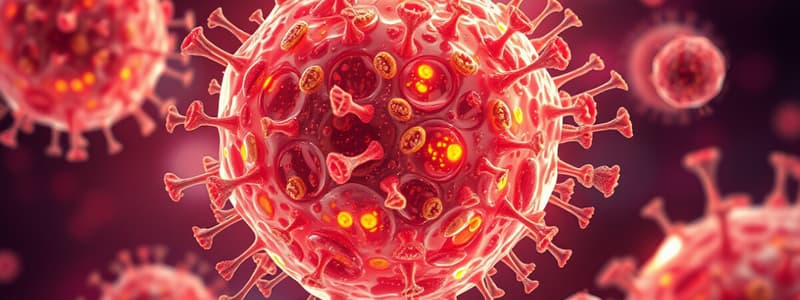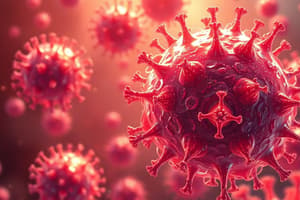Podcast
Questions and Answers
What is the role of lysozymes during phagocytosis?
What is the role of lysozymes during phagocytosis?
- They help in the formation of MHC class II molecules.
- They attract phagocytes to the pathogen.
- They initiate the process of exocytosis.
- They hydrolyse the pathogen within the phagosome. (correct)
What is the significance of MHC class II molecules in the phagocytosis process?
What is the significance of MHC class II molecules in the phagocytosis process?
- They help in the fusion of phagosomes and lysosomes.
- They assist in the absorption of the pathogen.
- They increase the speed of exocytosis.
- They are involved in presenting antigens to T-helper cells. (correct)
How do antibodies play a role in the phagocytosis of pathogens?
How do antibodies play a role in the phagocytosis of pathogens?
- They act as a chemical beacon to attract phagocytes. (correct)
- They encapsulate the pathogen in an exosome.
- They initiate the production of lysozymes.
- They hydrolyse the pathogen in lysosomes.
Which statement accurately describes exocytosis in phagocytes?
Which statement accurately describes exocytosis in phagocytes?
What triggers the attraction of phagocytes to a pathogen at the site of infection?
What triggers the attraction of phagocytes to a pathogen at the site of infection?
Which statement accurately describes the role of neutrophils in the immune response?
Which statement accurately describes the role of neutrophils in the immune response?
What is the significance of Pathogen Associated Molecular Patterns (PAMPs) in phagocytosis?
What is the significance of Pathogen Associated Molecular Patterns (PAMPs) in phagocytosis?
Which of the following best describes the process involved in phagocytosis after pathogen detection?
Which of the following best describes the process involved in phagocytosis after pathogen detection?
What role do opsonins play in the immune response?
What role do opsonins play in the immune response?
Which of these immune cells mainly develop in the lymphatic system and influence the adaptive immune response?
Which of these immune cells mainly develop in the lymphatic system and influence the adaptive immune response?
Where are neutrophils predominantly located in the body?
Where are neutrophils predominantly located in the body?
What happens during the activation step of phagocytosis?
What happens during the activation step of phagocytosis?
Which of the following statements is true regarding macrophages?
Which of the following statements is true regarding macrophages?
Which statement about neutrophils is true?
Which statement about neutrophils is true?
What is the role of Pathogen Recognition Receptors (PRRs) during phagocytosis?
What is the role of Pathogen Recognition Receptors (PRRs) during phagocytosis?
Which of the following correctly describes the relationship between opsonins and phagocytes?
Which of the following correctly describes the relationship between opsonins and phagocytes?
What initiates the activation of a phagocyte during phagocytosis?
What initiates the activation of a phagocyte during phagocytosis?
Which of the following statements accurately describes macrophages?
Which of the following statements accurately describes macrophages?
Flashcards are hidden until you start studying
Study Notes
Innate Immune Cells
- Innate immune cells are distributed throughout the body, including mucous membranes and deep tissues.
- They are prevalent in the lymphatic system, which consists of vessels extending across most of the body, allowing immune cells to travel.
Neutrophils and Macrophages
- Neutrophils are the most common type of phagocyte, produced in the bone marrow, and found in blood and tissue fluid.
- Neutrophils act quickly but are short-lived, playing a crucial role in the immediate immune response.
- Macrophages are larger than neutrophils and develop in lymph nodes, also made in bone marrow.
- Macrophages participate in the adaptive immune response, providing specific defense mechanisms.
Steps of Phagocytosis
- Phagocytosis, termed “cell eating”, allows cells to engulf and internalize pathogens.
- Detection occurs when phagocytes recognize unique antigens, called Pathogen Associated Molecular Patterns (PAMPs), through Pathogen Recognition Receptors (PRRs) on their surface.
- Phagocyte activation occurs when PRRs bind to PAMPs; interferons may also assist in this activation.
- Pathogens can be coated with opsonins, such as antibodies or complement proteins, facilitating easier binding and engulfment by phagocytes.
- The phagocyte engulfs the pathogen by extending cytoplasmic arms, forming a vesicle known as a phagosome.
- The phagosome merges with a lysosome that releases lysozymes, breaking down the pathogen through hydrolysis.
- Digestive products are absorbed by the phagocyte—some are discarded via exocytosis, while others are presented with MHC class II molecules to activate T-helper cells.
Finding the Pathogen
- Phagocyte attraction to pathogens occurs through two mechanisms:
- Antibodies bind to pathogens, acting as chemical beacons to recruit phagocytes.
- Pathogens release chemicals that attract phagocytes to the infection site.
- Both mechanisms are functions of chemotaxis, guiding immune cells toward pathogens.
Overview of Innate Immune Cells
- Innate immune cells are widely distributed throughout the body, including mucous membranes, deep tissues, and the lymphatic system.
- The lymphatic system serves as a complex transport system for immune cells, with vessels reaching most body areas.
Neutrophils
- Neutrophils, produced in the bone marrow, are the most abundant phagocytes found in blood and tissue fluid.
- They are characterized by their short lifespan and rapid response capability.
Macrophages
- Macrophages are larger phagocytes that develop in lymph nodes and also originate from bone marrow.
- They play a critical role in both innate and adaptive immune responses, engaging in specific immune activities.
Phagocytosis Process
- Detection: Phagocytes identify pathogens via unique antigens known as Pathogen Associated Molecular Patterns (PAMPs), recognized by Pathogen Recognition Receptors (PRRs) on phagocyte surfaces.
- Activation: The binding of PRRs to PAMPs triggers phagocyte activation, often aided by signaling molecules like interferons.
- Opsonization: Pathogens may be coated with opsonins (e.g., antibodies, complement proteins) to enhance binding and phagocytosis.
- Engulfment: Phagocytes extend cytoplasmic processes to engulf pathogens, forming a vesicle called the phagosome.
- Digestion: The phagosome merges with a lysosome, which releases lysozymes to hydrolyze and break down the pathogen.
- Absorption of Digestive Products: After digestion, the phagocyte absorbs hydrolysis products; waste is excreted via exocytosis, while some products are loaded onto MHC class II molecules for antigen presentation.
Locating Pathogens
- Antibody Attraction: Antibodies bind to pathogens and serve as chemical beacons to attract phagocytes.
- Chemical Attraction: Pathogens emit chemicals that draw phagocytes to the infection site, a process known as chemotaxis.
Studying That Suits You
Use AI to generate personalized quizzes and flashcards to suit your learning preferences.


